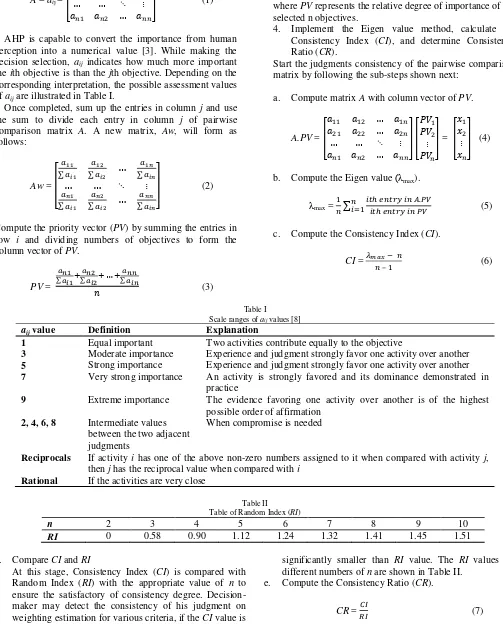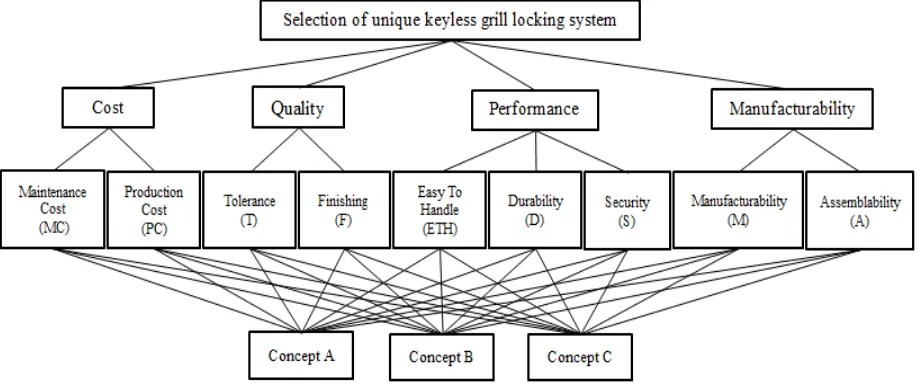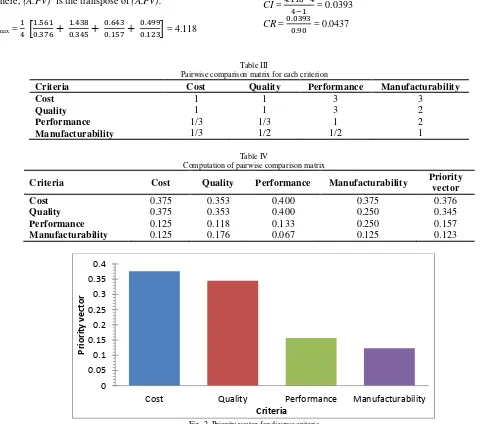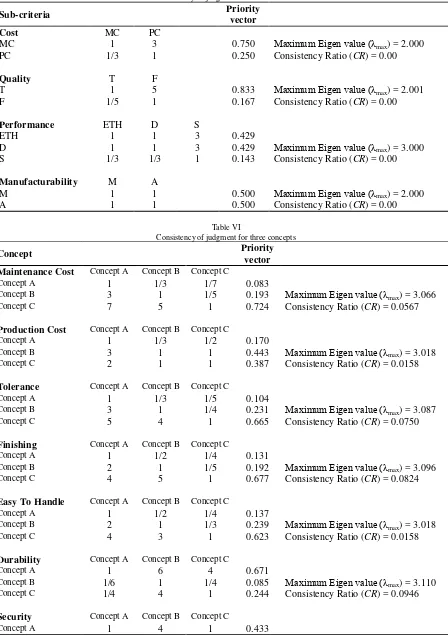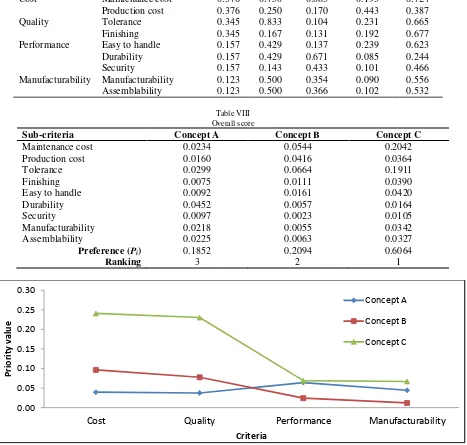143305-6969-IJMME-IJENS © October 2014 IJENS
I J E N S
AHP Based Decision-Making in Concept Selection of
Keyless Grill Locking System
Sivaraos
1, a, Si Qing Lim
1, A.R. Samsudin
1, Y. Yusof
3, C.F.Tan
2, Nona Merry M. Mitan
2, Amran
11
Faculty of Manufacturing Engineering, Universiti Teknikal Malaysia Melaka
2
Faculty of Mechanical Engineering, Universiti Teknikal Malaysia Melaka
3
Faculty of Mechanical and Manufacturing Engineering, Universiti Tun Hussein Onn Malaysia
a
Abstract-- Selection of appropriate unique keyless grill locking system concept which complies with customer and technical requirements is one of the complicated decision making problem. In order to solve this problem, an idea selection based on the application of Analytic Hierarchy Process (AHP) is developed. This technique breaks down the multi-criteria into several levels and computes them using pairwise comparison matrices. The concepts of unique keyless grill locking system were evaluated using four main criteria: cost, quality, performance, and manufacturability. The results of the study indicate that the optimum concept is selected based on the highest score achieved from the overall ranking of each alternative concept.
Index Term-- Analytic hierarchy process, keyless grill locking system, multi-criteria decision making concept, pairwise comparison matrix
I. INTRODUCTION
The decision making process for selecting unique keyless grill locking system concept is affected by the aspect of performance and quality in securing human life and occupancy properties. Due to various feasible alternatives and conflicting objectives, the selection of keyless grill locking system concept under constrained performances or requirements is a complicated task. Under these constraints, analytic hierarchy process (AHP) is applied for multi-criteria decision making as it is one of the most flexible and widely used tools [1], [15]. Under specific conditions and customer requirements, the present study was to develop systematic steps for choosing first rank concept of unique keyless grill locking system.
II. MULTI-CRITERIA DECISION MAKING TOOL A common problem in multi-criteria decision making approach is using weighting scheme to create a single measure from the combination of various measures. This weighting scheme has faced the difficulty in developing the importance of decision making criteria which are justified and divided by decision makers [2]. A variety of techniques are used to obtain the weights for various criteria, which AHP is one of the techniques to distill from a wide range of criteria into a single measure. AHP allows decision makers to assess generated products through criteria weightage and select the
highest index of product to finalize the decision making [3]. Through the use of AHP, any complicated problem can be divided into several sub-problems, which form the hierarchical levels whereby each sub-problem is related with the criteria above of it [4], [5].
Conventional key-based mortise lock is widely used in the present market. The grill door mortise lock has weaknesses in providing the highest security. During an emergency situation, the grill door mortise lock always faces difficulty in locking the grill instantly. To overcome the drawback, three new concepts of grill locking system have been generated and classified as Concept A, Concept B, and Concept C. A basic organizing tool for keyless grill locking system selection is to be developed due to the multitude of characteristics and design concepts [6]. Based on selected factors, taxonomy of criteria and sub-criteria is expanded and AHP technique is implemented to select the first rank concept of keyless grill locking system.
III. ANALYTIC HIERARCHY PROCESS
AHP is a democratic decision making method, used to solve complicated problems including multiple criteria. It is an Eigen value approach to the pair-wise comparisons [1], developed by Thomas L. Saaty in 1971 [4]. Meanwhile, AHP is implemented as a tool to calibrate the quantitative and qualitative measurements of numeric scale. Decision makers should correspond in the preference ratings after the weights of attributes and alternative have been found [7]. The following are basic steps in the AHP based keyless grill locking system concept [16]:
1. State the problem and broaden the objective based on the problem.
2. Develop the hierarchy consists of different levels including objective, criteria, sub-criteria, and alternatives. 3. Construct a set of pairwise comparison matrices to
compare each element in the corresponding level.
143305-6969-IJMME-IJENS © October 2014 IJENS
the ith objective is than the jth objective. Depending on the corresponding interpretation, the possible assessment values
Compute the priority vector (PV) by summing the entries in row i and dividing numbers of objectives to form the where PV represents the relative degree of importance of the selected n objectives.
4. Implement the Eigen value method, calculate the Consistency Index (CI), and determine Consistency Ratio (CR).
Start the judgments consistency of the pairwise comparison matrix by following the sub-steps shown next:
a. Compute matrix A with column vector of PV.
aij value Definition Explanation
1 Equal important Two activities contribute equally to the objective
3 Moderate importance Experience and judgment strongly favor one activity over another
5 Strong importance Experience and judgment strongly favor one activity over another
7 Very strong importance An activity is strongly favored and its dominance demonstrated in then j has the reciprocal value when compared with i
Rational If the activities are very close
Table II ensure the satisfactory of consistency degree. Decision-maker may detect the consistency of his judgment on weighting estimation for various criteria, if the CI value is
significantly smaller than RI value. The RI values for different numbers of n are shown in Table II.
e. Compute the Consistency Ratio (CR).
CR =
143305-6969-IJMME-IJENS © October 2014 IJENS
I J E N S The degree of consistency is satisfactory if CR ≤ 0.10,
otherwise, there are inconsistencies if CR > 0.10. Based on Saaty, the AHP result is insignificant if CR value is higher than 0.10 [9]. Thus, judgments should be re-examined and modified as necessary in order to reduce the inconsistency to 0.10 or lower.
5. Repeat step 3 and 4 in order to have the desired normalized values for each sub-criteria of all levels. 6. Analyze the normalized values and drive solution to the
problem.
IV. CASE STUDY
AHP technique had been implemented with detail steps involved to select the optimal keyless grill locking system concept. The decision making process is began after the problems and objective had been justified.
A. The Selection Hierarchy
Beginning, the AHP builds the hierarchical assessment system and each hierarchy responds to the single target of the last hierarchy [20]. Figure 1 illustrates the hierarchy for the selection of keyless grill locking system concept. It was
classified into four levels which include the objective, criteria, sub-criteria and concepts [17].
The main objective in this selection is to select the best keyless grill locking system concept from three alternative concepts. The second hierarchy level comprised cost, quality, performance, and manufacturability. Those criteria are selected based on customer requirements and also supported by the technical view of authors in this paper. This is because AHP method requires expert advice from end users for affecting factors determination [14]. The third level comprised different sub-criteria that emerged from the second level. There have three concepts in fourth level, including Concept A, Concept B and Concept C. The instantly lock feature of Concept A is located at key plate, which convenience users to unlock the grill door. However, the effectively in unlock the grill door for Concept A is similar as the conventional mortise lock. Concept B has benefits in easily to handle and lock the grill door instantly, but the unlock feature is not efficiently. The Concept C has innovative lock and unlock feature for grill door. Yet, the manufacturability of this concept is doubted.
Fig. 1. Hierarchy for the keyless grill locking system concept selection problem
B. Pairwise Comparison Matrices
Elements in the lower level will be governed by the elements in the higher level [10]. Thus, the elements in the lower level will be compared with each other based on the effects that derived by elements in the higher level. The results for pairwise comparison matrix for the criteria in level II of the developed hierarchy is shown in Table III.
Afterward, each entry in the column of the pairwise comparison matrix was standardized by dividing the sum of the corresponding column entries. The priority vector (PV) of each criterion can be established through summing and averaging the standardized elements for each row of the pairwise comparison matrix as illustrated in Table IV.
The priority vector (PV) refers to the weighting values for different criteria involved in the selection process of keyless
grill locking system concept [11]. Figure 2 exhibits the priority vector for unique keyless grill locking system concept selection criteria.
C. Judgments Consistency
In order to determine the consistency of judgments, the use of Eigen value method is necessary to evaluate the maximum
Eigen value (λmax) of the pairwise comparison matrix. Based on the computed process, the value of Consistency Ratio (CR) was 0.0437, which was less than 0.10, reflecting that the consistency of judgments at level II was consistent and acceptable [12].
143305-6969-IJMME-IJENS © October 2014 IJENS
I J E N S where, (A.PV)T is the transpose of (A.PV).
λmax =
[
]
= 4.118CI =
= 0.0393 CR =
= 0.0437
Table III
Pairwise comparison matrix for each criterion
Criteria Cost Quality Performance Manufacturability
Cost 1 1 3 3
Quality 1 1 3 2
Performance 1/3 1/3 1 2
Manufacturability 1/3 1/2 1/2 1
Table IV
Computation of pairwise comparison matrix
Criteria Cost Quality Performance Manufacturability Priority
vector
Cost 0.375 0.353 0.400 0.375 0.376
Quality 0.375 0.353 0.400 0.250 0.345
Performance 0.125 0.118 0.133 0.250 0.157
Manufacturability 0.125 0.176 0.067 0.125 0.123
Fig. 2. Priority vector for diverse criteria
D. Sub-Criteria Pairwise Comparison Matrices
The priorities of the sub-criteria with respect to different criteria in the level II can be obtained from the pairwise comparison matrices. In order to reach the desired composite priority vectors for the alternative concept, the results for vector of priorities can then be weighted by the priority vectors of the third level [6]. Table V is developed when the sub-criteria under different criteria are compared pairwise.
E. Model Assessment and Final Selection
Previously, the weighting values for different criteria and sub-criteria were calculated. Those priority vectors were ready for applied to find out the overall ranking of alternative concept of keyless grill locking system [13]. In this respect, the alternative concepts were pairwise compared with various sub-criteria on the third level of the hierarchy as tabulated in Table VI. Those numerical weight or priority is derived for each element of the hierarchy, allowing diverse and often
incommensurable elements to be compared to one another in a rational and consistency way [19].
In Table VII, Wt1 and Wt2 represent the weighting values for
the criteria and sub-criteria of the second level and third level. The priority vector values of alternative keyless grill locking system concepts compared with respect to the sub-criteria on the third level of the hierarchy were obtained in the last three columns of the table.
Table VIII provides the results for the overall score of each alternative keyless grill locking system concept. Those overall score were computed by multiplying respective value of Wt1,
Wt2 with the priority vector of each alternative. Finally, adding
up the results summed as tabulated in Table VIII. The overall score and rank of each alternative keyless grill locking system concept is also provided to give a better picture of selection. Based on the data, Concept C is the most preferred for unique keyless grill locking system, as this concept meets the customer requirements in-line with the view of technical points.
0 0.05 0.1 0.15 0.2 0.25 0.3 0.35 0.4
Cost Quality Performance Manufacturability
Pr
io
ri
ty vec
to
r
143305-6969-IJMME-IJENS © October 2014 IJENS
I J E N S Table V
Consistency of judgment for all sub-criteria
Sub-criteria Priority
vector
Cost MC PC
Maximum Eigen value (λmax) = 2.000 Consistency Ratio (CR) = 0.00
MC 1 3 0.750
PC 1/3 1 0.250
Quality T F
Maximum Eigen value (λmax) = 2.001 Consistency Ratio (CR) = 0.00
T 1 5 0.833
F 1/5 1 0.167
Performance ETH D S
Maximum Eigen value (λmax) = 3.000 Consistency Ratio (CR) = 0.00
ETH 1 1 3 0.429
D 1 1 3 0.429
S 1/3 1/3 1 0.143
Manufacturability M A
Maximum Eigen value (λmax) = 2.000 Consistency Ratio (CR) = 0.00
M 1 1 0.500
A 1 1 0.500
Table VI
Consistency of judgment for three concepts
Concept Priority
vector
Maintenance Cost Concept A Concept B Concept C
Maximum Eigen value (λmax) = 3.066 Consistency Ratio (CR) = 0.0567
Concept A 1 1/3 1/7 0.083
Concept B 3 1 1/5 0.193
Concept C 7 5 1 0.724
Production Cost Concept A Concept B Concept C
Maximum Eigen value (λmax) = 3.018 Consistency Ratio (CR) = 0.0158
Concept A 1 1/3 1/2 0.170
Concept B 3 1 1 0.443
Concept C 2 1 1 0.387
Tolerance Concept A Concept B Concept C
Maximum Eigen value (λmax) = 3.087 Consistency Ratio (CR) = 0.0750
Concept A 1 1/3 1/5 0.104
Concept B 3 1 1/4 0.231
Concept C 5 4 1 0.665
Finishing Concept A Concept B Concept C
Maximum Eigen value (λmax) = 3.096 Consistency Ratio (CR) = 0.0824
Concept A 1 1/2 1/4 0.131
Concept B 2 1 1/5 0.192
Concept C 4 5 1 0.677
Easy To Handle Concept A Concept B Concept C
Maximum Eigen value (λmax) = 3.018 Consistency Ratio (CR) = 0.0158
Concept A 1 1/2 1/4 0.137
Concept B 2 1 1/3 0.239
Concept C 4 3 1 0.623
Durability Concept A Concept B Concept C
Maximum Eigen value (λmax) = 3.110 Consistency Ratio (CR) = 0.0946
Concept A 1 6 4 0.671
Concept B 1/6 1 1/4 0.085
Concept C 1/4 4 1 0.244
Security Concept A Concept B Concept C
143305-6969-IJMME-IJENS © October 2014 IJENS
I J E N S Concept B 1/4 1 1/5 0.101 Maximum Eigen value (λmax) = 3.006
Consistency Ratio (CR) = 0.0048
Concept C 1 5 1 0.466
Manufacturability Concept A Concept B Concept C
Maximum Eigen value (λmax) = 3.054 Consistency Ratio (CR) = 0.0465
Concept A 1 5 1/2 0.354
Concept B 1/5 1 1/5 0.090
Concept C 2 5 1 0.556
Assemblability Concept A Concept B Concept C
Maximum Eigen value (λmax) = 3.095 Consistency Ratio (CR) = 0.0817
Concept A 1 5 1/2 0.366
Concept B 1/5 1 1/4 0.102
Concept C 2 4 1 0.532
Table VII
Priority vector values for different criteria, sub-criteria and alternatives
Criteria Sub-criteria Wt1 Wt2
Concept A
Concept B
Concept C
Cost Maintenance cost 0.376 0.750 0.083 0.193 0.724
Production cost 0.376 0.250 0.170 0.443 0.387
Quality Tolerance 0.345 0.833 0.104 0.231 0.665
Finishing 0.345 0.167 0.131 0.192 0.677
Performance Easy to handle 0.157 0.429 0.137 0.239 0.623
Durability 0.157 0.429 0.671 0.085 0.244
Security 0.157 0.143 0.433 0.101 0.466
Manufacturability Manufacturability 0.123 0.500 0.354 0.090 0.556
Assemblability 0.123 0.500 0.366 0.102 0.532
Table VIII Overall score
Sub-criteria Concept A Concept B Concept C
Maintenance cost 0.0234 0.0544 0.2042
Production cost 0.0160 0.0416 0.0364
Tolerance 0.0299 0.0664 0.1911
Finishing 0.0075 0.0111 0.0390
Easy to handle 0.0092 0.0161 0.0420
Durability 0.0452 0.0057 0.0164
Security 0.0097 0.0023 0.0105
Manufacturability 0.0218 0.0055 0.0342
Assemblability 0.0225 0.0063 0.0327
Preference (Pi) 0.1852 0.2094 0.6064
Ranking 3 2 1
Fig. 3.Performance of each alternative concept
0.00 0.05 0.10 0.15 0.20 0.25 0.30
Cost Quality Performance Manufacturability
Pr
io
ri
ty val
u
e
Criteria
Concept A
Concept B
Concept C
143305-6969-IJMME-IJENS © October 2014 IJENS
I J E N S Through the results obtained from Table VIII, it is obvious
that the „Maintenance cost‟ shows the highest value of 0.2042 for Concept C as compared to other two concepts. This is due to the internal mechanical structure for Concept A where Concept B is more complex compared to Concept C. The ability for Concept A and B to sustain the collapsing force is spontaneously low due to the complex internal design. Thus, maintenance cost is necessary and relatively high for Concept
A and B. Furthermore, „Tolerance‟ as one of the sub-criteria shows bigger value of 0.1911 in Concept C against 0.0299 for Concept A and 0.0664 for Concept B. Tolerance is part of the critical issues which will affect the overall performance of the keyless grill locking system. In this point, Concept A and Concept B reflects poor performance due to their complex internal mechanical design even though the durability of Concept A is relatively high.
Figure 3 exhibits the capability of the alternative keyless
grill locking system concept with respect to “Cost”, “Quality”, “Performance”, and “Manufacturability”. Based on Figure 3, it is observed that Concept C has outperformed the other two concepts. In the „Cost‟ criteria, the incomplex design for manufacturing and maintenance of Concept C shows excellent performance in production cost and maintenance cost, which is cost effective. Concept B reflects the worse outcome in the
„Manufacturability‟ criteria due to certain critical parts for
manufacture. Concept A has improper mechanical design as more parts are required. Thus, because of high cost and low quality, Concept A has the lowest rank among the three keyless grill locking system concepts. However it achieves a better result in „Manufacturability‟ criteria than Concept B. The AHP pairwise comparisons have been derived mathematically from the requirements of end users. Commonly, alternatives set in a hierarchical structure are subjectively evaluated through AHP technique [18]. However, this case study is paired with tangible inputs and outputs of data. Thus, no subjective assessment from the decision maker is involved.
V. CONCLUSION
The concept selection model of unique keyless grill locking system is designed based on pairwise comparison matrices implementation for multi-criteria decision making problems. This approach provides a more accurate result than other simple scoring techniques as it considers all important criteria together with their alternatives simultaneously. Besides framing the problem, AHP method establishes weights for different criteria. Thus, the judgment or weighting values bias will not arise among the decision maker for the criteria. By employing the AHP technique, Concept C is the most preferred keyless grill locking system, as it reaches the highest priority value compared to the other concept. Based on the result, “Cost” is the most important criteria in product development. As a knowledge-based system, AHP technique can also fulfill various other requirements along with the implementation of pairwise comparisons.
ACKNOWLEDGMENTS
The authors would like to thank the Minister of Higher Education, and Economic Planning Unit of Malaysia for awarding this Knowledge Transfer Programme Grant [Grant number: Gluar/2013/FKP(1) /G00019]. Special thanks are extended to Universiti Teknikal Malaysia Melaka and Faculty of Manufacturing Engineering for providing the facilities and support. In addition, the authors wish to thank Ms. Zanariah Jano from Centre for Languages and Human Development, of the same Universiti for her contribution in grammatical checking.
REFERENCES
[1] O. S. Vaidya and S. Kumar, (2006). Analytic Hierarchy Process: An Overview of Applications, European Journal of Operational Research, vol. 169, pp. 1-29.
[2] Z. Jiang, H. Zhang, and J. W. Sutherland, (2011). Development of Multi-Criteria Decision Making Model for Remanufacturing Technology Portfolio Selection, Journal of Cleaner Production, vol. 19, pp. 1939-1945.
[3] M. F. Hassan, M. Z. M. Saman, S. Sharif, and B. Omar, (2012). An Integrated MA-AHP Approach for Selecting the Highest Sustainability Index of A New Product, Procedia-Social and Behavioral Sciences, vol. 57, pp. 236-242. [4] T. L. Saaty, (1980). The Analytic Hierarchy Process, New
York: McGraw Hill.
[5] T. L. Saaty, (1990). Decision Making for Leaders, Pittsburgh: RWS Publications.
[6] S. Chakraborty and D. Banik, (2006). Design of A Material Handling Equipment Selection Model Using Analytic Hierarchy Process, Int. J. Adv. Manuf. Technol., vol. 28, pp. 1237-1245.
[7] A. Anvari, N. Zulkifli, S. Sorooshian, and O. Boyerhassani, (2014). An Integrated Design Methodology Based on the Use of Group AHP-DEA Approach for Measuring Lean Tools Efficiency with Undesirable Output, Int. J. Adv. Manuf. Technol., vol. 70, pp. 2169-2186. [8] T. L. Saaty, (2008). Decision Making with the Analytic
Hierarchy Process, Int. J. Services Sci., vol. 1, pp. 83-98. [9] T. L. Saaty, (1990). How to Make A Decision: The
Analytic Hierarchy Process, Eur. J. Oper. Res., vol. 48, pp. 9-26.
[10] E. H. Forman and S. I. Gass, (2001). The Analytic Hierarchy Process – An Exposition, Oper. Res., vol. 49, pp. 469-486.
[11] T. L. Saaty, (2003). Decision-Making with the AHP: Why Is the Principal Eigenvector Necessary, Eur. J. Oper. Res., vol. 145, pp. 85-91.
[12] M. Sambasivan and N. Y. Fei, (2008). Evaluation of Critical Success Factors of Implementation of ISO 14001 Using Analytic Hierarchy Process (AHP): A Case Study from Malaysia, Journal of Cleaner Production, vol. 16, pp. 1424-1433.
[13] S. Lipovetsky and W. M. Conklin, (2002). Robust Estimation of Priorities in the AHP, Eur. J. Oper. Res., vol. 137, pp. 110-122.
143305-6969-IJMME-IJENS © October 2014 IJENS
I J E N S [15] Ravikumar M.M, Marimuthu. K, Parthiban. P, and
Abdul Zubar. H., (2013). Leanness Evaluation in 6
Manufacturing MSME‟s using AHP and SEM Techniques,
Int. J. Mechanical and Mechatronics Engineering, vol. 13, no. 06, pp. 29-36.
[16] Zeinhom El Alfy, Rasha Elhadary, and Ahmed Elashry, (2010). Integrating GIS and MCDM to Deal with Landfill Site Selection, Int. J. Engineering and Technology, vol. 10, no. 06, pp. 33-40.
[17] M. Omair, S. Noor, S. Maqsood, and R. Nawaz, (2014). Assessment of Sustainability in Marble Quarry of Khyber Pakhtunkhwa Province Pakistan, Int. J. Engineering and Technology, vol. 14, no. 03, pp. 84-89.
[18] Babak D. R. and Serpil Erol, (2009). A DEA-ANP Hybrid
Algorithm Approach to Evaluate a University‟s
Performance, Int. J. of Basic & Applied Sciences, vol. 09, no. 10, pp. 76-86.
[19] T. Sato, A. Sutoh, H. Nishi, and H. Arai, (2011). Identification of Correlation between Demand Performances to Damage of Lining Concrete for Tunnel Management, ScienceDirect: Procedia Engineering, pp. 529-534.
